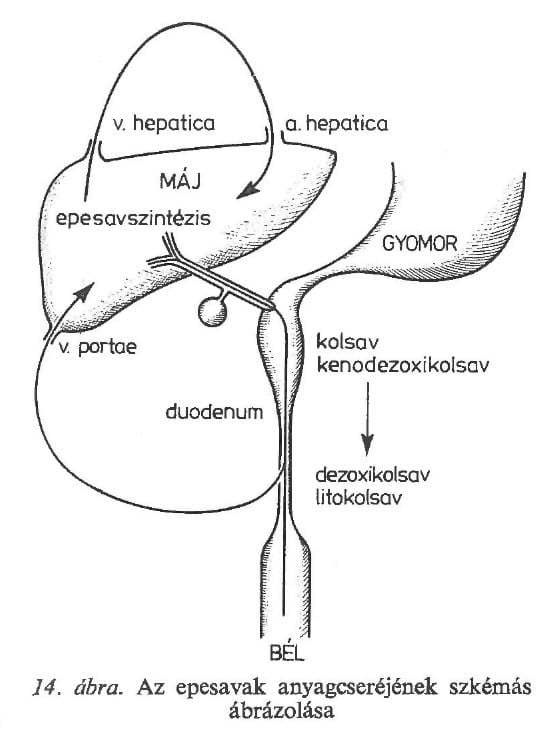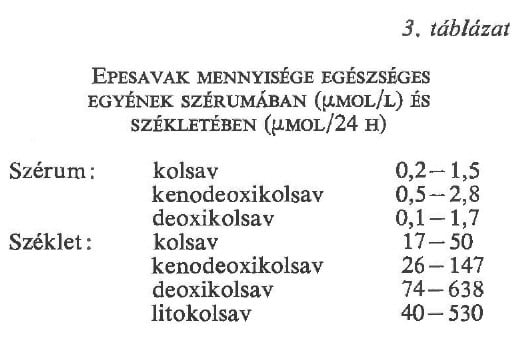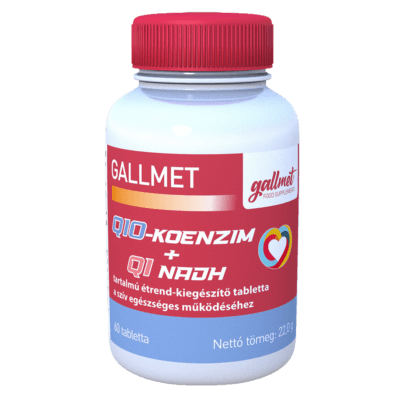Imre Magyar - Metabolism of bile acids
Source: Diseases of the liver, bile ducts and pancreas (Medicina Publishers 1985)
Bile acids are formed in the liver from cholesterol, secreted in the bile, transported to the intestine and transformed there (Figure 14). Primary bile acids are secreted with the bile and are primarily involved in the digestive process. Secondary bile acids are formed in the intestine, some of which are excreted in the faeces and some of which are absorbed.
The two most important primary bile acids are cholic acid and kenodeoxycholic acid. They are produced via 7-alpha-hydroxycholesterol by the enzyme 7-alpha-hydroxylase. The two primary bile acids are formed by further hydroxylation and reduction. Their formation is mainly influenced by the amount formed. If, for example, a high amount of bile acid is introduced into the intestine when chenodeoxycholic acid is administered, less bile acid is formed from cholesterol.
In this case, more cholesterol is retained, but the increase in cholesterol reduces its own synthesis. In biliary fistula, on the other hand, bile acids are excreted, regulation increases bile acid synthesis from cholesterol, but a decrease in cholesterol also increases cholesterol synthesis. The regulation takes place through the role of the 7-alpha hydroxylase mentioned above.
The activity of this enzyme is stimulated by thyroxine and inhibited by insulin. It also inhibits starvation.
The total amount of primary bile acids produced is about 600 mg in 24 hours. About twice as much kenodeoxycholic acid is produced as cholic acid.
These primary bile acids are already esterified with taurine and glycine in the liver [565]. These conjugated bile acids are transported to the bile and hold cholesterol in a micelle form in solution with phospholipids.
The micelle forming capacity is proportional to the degree of hydroxylation. In the intestine, primary bile acids allow fat absorption. They are absorbed from the lower ileum and transported to the liver. This is the enterohepatic cycle of bile acids (Figure 1.14).

Carboxylic acid esters and sulphate esters are also formed, and small amounts of bile acid glucuronate are also formed, which are rapidly excreted in the urine. However, most of the bile acids are excreted via the intestine.
The microorganisms in the large intestine produce deoxyolic acid from cholic acid and lithocholic acid from kenodeoxycholic acid by deconjugation, dehydroxylation. Litholeic acid is generally not absorbed, part of deoxycholic acid is absorbed and also participates in the enterohepatic cycle of bile acids, of which, however, only about 20-30% is contributed by litholeic acid and deoxycholic acid, i.e. secondary bile acids.
Absorption is the result of active transport processes [231].
Bile acids can be determined in serum, other body fluids and faeces by thin layer chromatography, enzymatic methods, gas chromatography and radioimmunoassay.
Due to the technical difficulties of determination, the quantification of bile acids has not been widely used in everyday practice.
The values [248, 249] determined in serum and faeces of healthy humans using our clinic's methodology are shown in Table 3.

As bile acids are produced from cholesterol, changes in their metabolism are mainly related to changes in cholesterol metabolism. In hypercholesterolaemia, usually hyperlipoproteinaemia, especially familial hypercholesterolaemia, bile acid excretion is substantially reduced, deoxycholic acid is barely detectable in the blood and the amount of secondary bile acids in the faeces is also reduced.
However, this may also be due to the rapid absorption of primary bile acids and the reduced production of secondary bile acids [22, 23, 585].
In liver disease, blood bile acid levels usually increase, but the increase is not proportional to the severity of the liver disease.
In our experiments [362, 548], we found that only concentrations of bile acids above 2.5 μmol/1 were a definite indicator of liver disease and that normal bile acid levels were found in a significant proportion of liver diseases. The concentration of kenodeoxycholic acid is normally higher than that of cholic acid. We have found that if the cholic acid/kenodeoxycholic acid ratio is greater than l, there is a high probability of cholestasis, in diffuse liver diseases the excretion of bile acids in the faeces is also reduced, but within the reduction, the amount of lithocholic acid is increased [847].
In acute hepatitis, bile acid synthesis is reduced and bile acid secretion is decreased. The reduced clearance results in increased bile acid levels in the blood, but also because bile acids absorbed from the intestine are not reabsorbed into the enterohepatic circulation due to liver dysfunction. Blood bile acids are particularly high in obstructive jaundice. We ourselves have found the highest values in primary biliary cirrhosis [548]. Bile acids that are carried by the circulation to the skin may be the cause of the excruciating itching that is a symptom of both extrahepatic and intrahepatic cholestasis.
In cholestasis, the amount of sulphate ese acids excreted in the urine is also strikingly high.
In principle, therefore, it is worthwhile to perform bile acid determinations in the blood and urine, and possibly in the faeces, of liver patients [49, 118], but it seems that, except in a few specific cases, the examination of fasting bile acid in the blood does not provide new information. For this reason, and because of technical difficulties, the determination of bile acids is difficult to enter the everyday clinical practice. Bile acid metabolism is also influenced by absorption. Thus, in malabsorption, the absorption of bile acids is reduced and a higher amount of secondary bile acids is produced. Of these, lithocholic acid is thought to play a role in the development of some diarrhoea.
Unfortunately, the metabolism of bile acids is influenced by too many factors and this makes it difficult to assess. Loading assays have been developed in the form of post-meal bile acid determinations [245, 414, 548, 787]. We ourselves [362] performed oral kenodeoxycholic acid loading. We have found that individual or whole blood bile acids in healthy individuals increase in one hour and decrease in two hours, but in liver disease the increase lasts beyond two hours. An intravenous assay has also been developed [477].
Bile acids, of course, play a major role in keeping bile cholesterol in solution and thus in the formation of bile. The primary cause of cholesterol stone formation appears to be a reduction in the bile acid pool.
Bile acids have an important role in the absorption of fats and, as mentioned above, the causes of diarrhoea include the accumulation of secondary bile acids in the intestine under certain circumstances (e.g. after intestinal resection, ileotransversostomy, etc.).
Our products are also available in pharmacies!
Click on the [print-me] icon to print the page


























